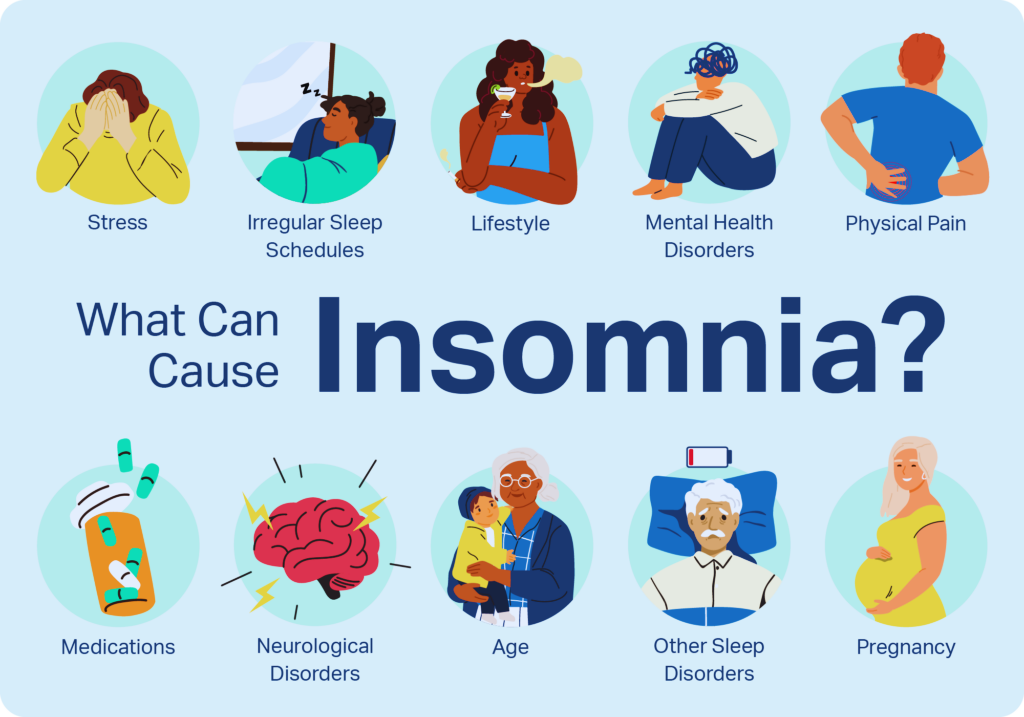In today’s fast-paced world, quality sleep is often overlooked, leading to a plethora of sleep disorders that can significantly impact one’s health and well-being. In this comprehensive guide, we’ll explore various sleep disorders, their causes, symptoms, and potential treatments.
Insomnia: The Widespread Sleep Disorder
Insomnia stands as one of the most prevalent sleep disorders, affecting millions worldwide. Individuals suffering from insomnia often experience difficulty falling asleep or staying asleep, leading to chronic sleep deprivation. Factors such as stress, anxiety, poor sleep hygiene, and certain medications can contribute to the development of insomnia. Symptoms may include daytime fatigue, irritability, and impaired cognitive function. Treatment approaches may include cognitive-behavioral therapy, relaxation techniques, and medication in severe cases.
Sleep Apnea: A Serious Health Concern
Another common sleep disorder, sleep apnea, poses a significant health risk if left untreated. This condition involves pauses in breathing during sleep, often due to obstructed airways or neurological issues. Obstructive sleep apnea (OSA) occurs when the muscles in the throat relax excessively, causing the airway to collapse. Central sleep apnea (CSA) stems from a malfunction in the brain’s respiratory control center. Symptoms of sleep apnea include loud snoring, gasping for air during sleep, and excessive daytime sleepiness. Treatment options range from lifestyle modifications, such as weight loss and positional therapy, to continuous positive airway pressure (CPAP) therapy and surgery in severe cases.
Restless Legs Syndrome (RLS): An Uncomfortable Sensation
Restless Legs Syndrome (RLS) manifests as an uncomfortable sensation in the legs, often described as tingling, crawling, or itching. This sensation typically worsens at night, leading to an irresistible urge to move the legs. RLS can significantly disrupt sleep patterns, causing chronic insomnia and daytime fatigue. Iron deficiency, neurological conditions, and genetics may contribute to the development of RLS. Treatment strategies may involve iron supplementation, medication, lifestyle changes, and stress management techniques to alleviate symptoms and improve sleep quality.
Narcolepsy: A Neurological Disorder
Narcolepsy is a neurological disorder characterized by excessive daytime sleepiness and sudden attacks of sleep. Individuals with narcolepsy may experience sudden loss of muscle tone (cataplexy), vivid hallucinations, and sleep paralysis. The exact cause of narcolepsy remains unclear, but it is believed to involve abnormalities in the brain’s sleep-wake cycle. Treatment typically involves medications to regulate sleep patterns and manage symptoms, along with lifestyle adjustments to enhance sleep hygiene.
Circadian Rhythm Sleep Disorders: Disrupted Body Clocks
Circadian rhythm sleep disorders result from disruptions to the body’s internal clock, which regulates the sleep-wake cycle. Shift work disorder, jet lag, and delayed sleep phase disorder are common examples of circadian rhythm sleep disorders. Shift workers, travelers, and individuals with irregular sleep schedules are particularly susceptible to these disruptions. Treatment strategies may include light therapy, melatonin supplements, and behavioral interventions to realign the body’s circadian rhythm with external cues.
Parasomnias: Abnormal Sleep Behaviors
Parasomnias encompass a range of abnormal sleep behaviors that occur during specific sleep stages. Examples include sleepwalking, night terrors, and REM sleep behavior disorder (RBD). Parasomnias can be alarming for both the individual experiencing them and their loved ones. Stress, sleep deprivation, and underlying medical conditions may trigger parasomnias. Treatment approaches may involve improving sleep hygiene, addressing underlying health issues, and implementing safety measures to prevent injury during episodes.
Frequently Asked Questions (FAQs) about sleep disorders
1. What are the common causes of sleep disorders?
Answer: Sleep disorders can stem from various factors, including stress, anxiety, lifestyle habits (such as irregular sleep schedules), underlying medical conditions (such as sleep apnea or restless legs syndrome), and certain medications. Additionally, disruptions to the body’s internal clock, known as the circadian rhythm, can contribute to developing sleep disorders.
2. How can I tell if I have a sleep disorder?
Answer: Recognizing the signs and symptoms of a sleep disorder is crucial for seeking appropriate treatment. Common indicators include difficulty falling or staying asleep, excessive daytime sleepiness, loud snoring, pauses in breathing during sleep, restless legs or involuntary movements during sleep, and recurring episodes of unusual sleep behaviors (such as sleepwalking or night terrors). If you experience any of these symptoms regularly, it’s advisable to consult a healthcare professional for evaluation and diagnosis.
3. What are the potential consequences of untreated sleep disorders?
Answer: Untreated sleep disorders can have significant ramifications on both physical and mental health. Chronic sleep deprivation, resulting from conditions like insomnia or sleep apnea, can weaken the immune system, impair cognitive function, increase the risk of cardiovascular diseases, and contribute to mood disorders such as depression and anxiety. Additionally, sleep disorders can negatively impact quality of life, productivity, and overall well-being.
4. How are sleep disorders diagnosed and treated?
Answer: The diagnosis of sleep disorders typically involves a comprehensive evaluation by a healthcare provider, which may include a thorough medical history review, physical examination, and sleep study (polysomnography) conducted in a sleep laboratory or through home-based sleep monitoring devices. Treatment approaches vary depending on the specific sleep disorder and may include lifestyle modifications (such as improving sleep hygiene), behavioral therapies (such as cognitive-behavioral therapy for insomnia), medications, and, in some cases, surgical interventions (such as for sleep apnea). Consulting a qualified healthcare professional for personalized diagnosis and treatment recommendations is essential.
Conclusion: Prioritizing Quality Sleep
In conclusion, sleep disorders encompass a diverse range of conditions that can significantly impair one’s quality of life if left untreated. As SEO experts and copywriters, it’s essential to raise awareness about these disorders and provide valuable information to empower individuals to seek help and improve their sleep health. By understanding the causes, symptoms, and treatment options for sleep disorders, we can work towards promoting better sleep hygiene and overall well-being.

